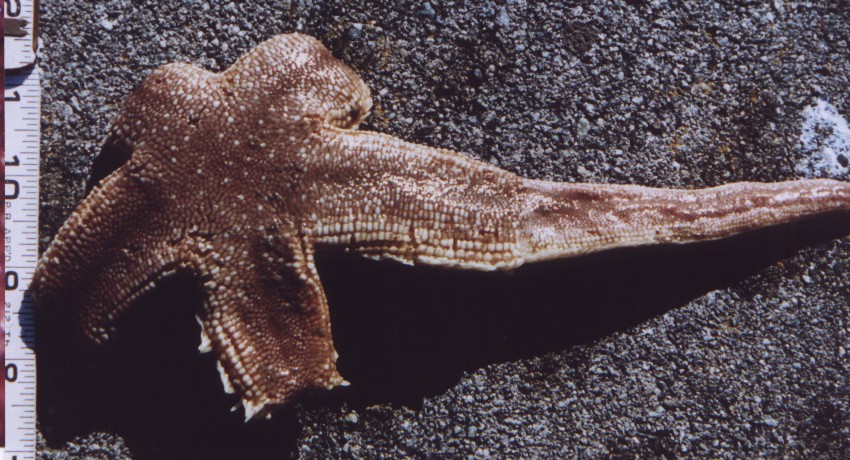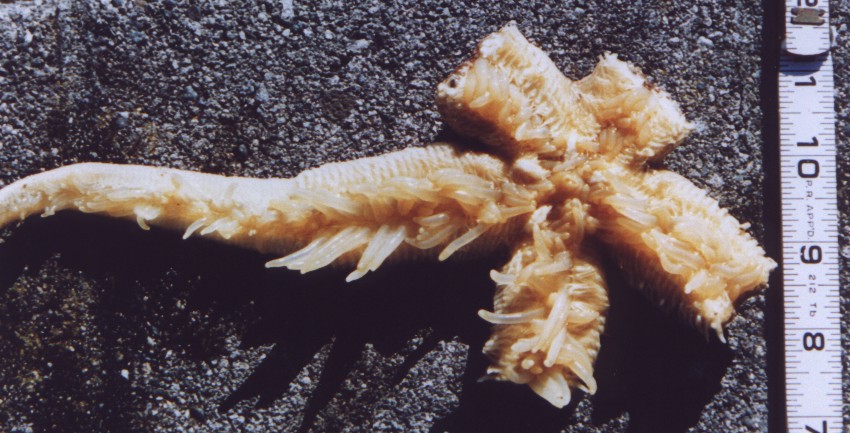Luidia foliolata Grube, 1866Common name(s): Spiny mudstar, Sandstar, Leafy flat star |
|
| Synonyms: Petalaster foliolata |  |
| Phylum Echinodermata
Class Asteroidea Order Platyasterida Family Luidiidae |
|
| Luidia foliolata captured at 100 m depth by trawl in the San Juan channel | |
| (Photo by: Dave Cowles, July 2000) | |
How to Distinguish from Similar Species: The only other stars with 5 rays and conspicuous marginal plates have marginal plates easily visible from above. Mediaster aequalis has no spines on its marginal plates and has suckers on the tube feet.
Geographical Range: Southeast Alaska to San Diego, CA
Depth Range: 12 to 600 m
Habitat: Sand and mud, nearly always subtidal, often half buried.
Biology/Natural History: Pointed tube feet without suckers are common on seastars which live on sand instead of rocks. This species seems very fragile--I have captured a number of specimens by otter trawl but all have been fragmented. This star is reported to eat the sea cucumber Cucumaria miniata.
This species burrows. It has a very leaky outer surface, and allows seawater fluids to pass readily through its surface. However, it tends to be hyperosmotic. It appears to make extensive use of seawater intake through its madreporite to maintain internal fluid balance (Ferguson, 1994).
| Return to: | |||
| Main Page | Alphabetic Index | Systematic Index | Glossary |
References:
Dichotomous Keys:Flora and Fairbanks, 1966
Kozloff 1987, 1996
General References:
Gotshall
and Laurent, 1979
Harbo,
1999
O'Clair
and O'Clair, 1998
Scientific Articles:
Ferguson, John C., 1994. Madreporite inflow of seawater to maintain body fluids in five species of starfish. pp. 285-289 in Bruno David, Alain Guille, Jean-Pierre Feral, and Michel Roux (eds). Echinoderms through time. Balkema, Rotterdam.
George, S.B., 1994. Phenotypic plasticity in the larvae of Luidia foliata (Echinodermata: Asteroidea). pp. 297-307 in Bruno David, Alain Guille, Jean-Pierre Feral, and Michel Roux (eds). Echinoderms through time. Balkema, Rotterdam.
Knott, K. Emily, and Gregory A. Wray, 2000. Controversy and consensus
in Asteroid systematics: new insights to Ordinal and Familial
relationships. American Zoologist 40:3 pp. 382-392
General Notes and Observations: Locations, abundances, unusual behaviors:

A view of the underside. Note the long tube feet have no suckers on the end. Photo by Dave Cowles, July 2000
Authors and Editors of Page:
Dave Cowles (2005): Created original page